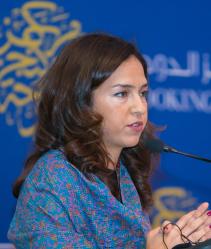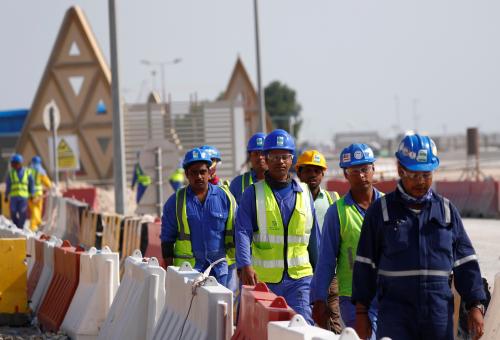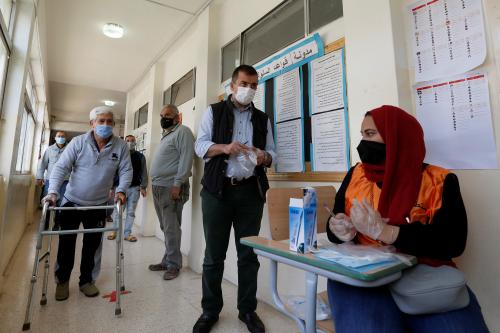Content from the Brookings Doha Center is now archived. In September 2021, after 14 years of impactful partnership, Brookings and the Brookings Doha Center announced that they were ending their affiliation. The Brookings Doha Center is now the Middle East Council on Global Affairs, a separate public policy institution based in Qatar.
We’ve heard it all before. Women are sexually harassed and assaulted. Women are discriminated against in the workplace. Women are excluded from political decision-making. Even women who “have it all” can’t seem to get it right. Working mothers are reprimanded for not being present enough for their children or at work.
International Women’s Day comes and goes every year. But it fails to account for the diverse grievances, needs, and expectations of women in varied contexts. Some criticize it as an occasion that turns the recognition of women and their achievements into an exceptional circumstance, a day-long celebration on the 8th of March. After that, normality resumes – a normality in which the patriarchy dismisses issues affecting women, and in which women are discriminated against, harassed, and marginalized on a daily basis.
While violations against women are universal, differences arise in the ways in which advocacy campaigns address the plight of women in varied contexts. Some criticize the #MeToo movement for speaking only to white, privileged women (despite its black female origins). They question the extent to which its supporters consider the movement as equally representative of Arab Muslim women, for example. This is because, as Yasmin El Rifae eloquently explains, sexual violence against Arab women is almost always attributed to Islam and Arab culture, as opposed to patriarchal power structures that adversely affect women in the rest of the world as well.
Such arguments draw attention to the importance of intersectional feminism. Intersectionality, as many have convincingly argued, requires that the multiple layers of oppression faced by women in diverse contexts be seriously addressed. For example, the plight of an Arab, Muslim woman is almost never identical to her white, non-Muslim counterpart. Yet, it is assumed to be by the overwhelmingly Western-dominated approaches to feminism, whether in practice or in literature. Differences in race, economic status, religion, and culture result in different experiences of oppression. They also yield different worldviews and different demands and needs from woman to woman.
The slideshow and accompanying captions of this piece on Iranian women shedding their headscarves is an unfortunate example of the oversimplification of women’s issues, particularly in the Middle East. Cursory caveats uncomfortably acknowledging that some Muslim women indeed wear the headscarf voluntarily fail to absolve the authors of such portrayals of any orientalist convictions. Such pieces reinforce the farcical notion that the experience of the “oppressed Muslim woman” is a universal one.
Muslim women the world over, it seems, have no agency.
At face value, gender equality in the political, economic, and social sense is indeed a worthwhile goal. However, policies aiming to implement this can and have often overlooked and vehemently dismissed the aspirations of women from diverse – i.e. non-white – contexts. This results in policies that become an added layer of oppression for many women. Some women, for instance, would like to go about their parliamentarian business while breastfeeding. Some Muslim women would like to perform their political duties while having the freedom to cover their hair if they wish. Some would even like to have the liberty to cover their hair and limbs at the beach.
Some international organizations and NGOs are not exempt from perpetuating this false image of the universal plight of women. Moreover, they have increasingly come under scrutiny for being party to the horrific exploitation of women. This recent report on the sexual abuse of Syrian women in return for aid is a shocking revelation of the extent to which this exploitation is rampant and its consequent crippling effect on the women who seek aid to feed themselves and their families amidst a brutal war.
Of course, women of color are subjected to racism and other forms of discrimination on a daily basis in a variety of contexts, and not only in conflict zones.
As an Arab Muslim woman and a working mother, I have been told repeatedly by my Western female colleagues and acquaintances how “amazing” I am – a role model, even – for other poor, oppressed, Arab Muslim female souls out there. While one can attribute such well-intentioned remarks to ignorance, most of these remarks have been made by highly educated Western women who live in the Arab region and work with Arab women on a daily basis. The message is clear: you are a role model not necessarily for the quality of your work, but for the number of tasks you juggle while maintaining a smile on your face, which is made all the more praiseworthy given your “exotic” and oppressed origins.
I was once told by one of these women how “impressive” and “awe-inspiring” it is that my mother, who is an Egyptian female, speaks English and holds a PhD. But I suspect the word this person was really searching for is “lucky.” You must have worked exceptionally hard to earn this prestigious position that comes naturally to women in the West. You are lucky you got to where you are, considering you are not…well…white.
But a tirade against white women and men is not the point here. It is perplexing, if not deeply depressing that, in 2018, misogyny, sexism, and racism continue to plague women on so many levels. My academic experience several years ago was dotted with such encounters emanating from patriarchal institutional structures. I was once assigned to lead a two-hour lecture on Islamic law, despite the fact that I had made clear I am not an Islamic law expert. But apparently my name, Noha Aboueldahab, was Arab enough and Muslim enough for me to be able to drum up a lecture to an audience that deserved better. Had I been male and objected to this, I suspect the outcome would have been different.
I chose to exclusively breastfeed my three children, which was made more difficult by the lack of basic consideration by Western academic institutions. At conferences, I often nursed in a bathroom stall or the back seat of a car. When I raised the issue, my concerns were “well-noted.” At the next conference I attended, there was indeed a room set aside for breastfeeding. When it was time for me to nurse, the door was locked. There was a note on the door with Sally’s phone number should there be any problems. I called Sally. She never answered. Back to the bathroom stall I went.
There are, of course, exceptions. A Chicago conference I attended several years ago had a day care set up at the same conference venue, which was perfect for me and my 11-month-old baby at the time. A conference I attended in Cairo dedicated a hall with a lock on the door for nursing participants. I am puzzled by why such accommodations have not become the norm in academe and other professional domains.
The inaccessible nursing room is eerily symbolic of the multiple challenges women continue to face the world over. The policies might be there, the initiatives may be begrudgingly taken, but they still fail in one way or another, largely because of the patriarchal power hierarchies that orchestrate them. Even when such policies are driven by an organized feminist movement, the end result is often not what was initially envisaged. This is presumably because of the patriarchal processes that tainted them along the way.
Feminism grapples with multiple and complex levels of oppression. However, many movements emanating from it, including International Women’s Day, have repeatedly fallen short in adequately addressing women’s grievances in diverse contexts. So long as International Women’s Day and its related advocacy campaigns continue to be hijacked by Western narratives of emancipation, they will continue to mean little for women of diverse races, cultures, and religions.




Commentary
Op-edHappy (not so) International Women’s Day
March 8, 2018